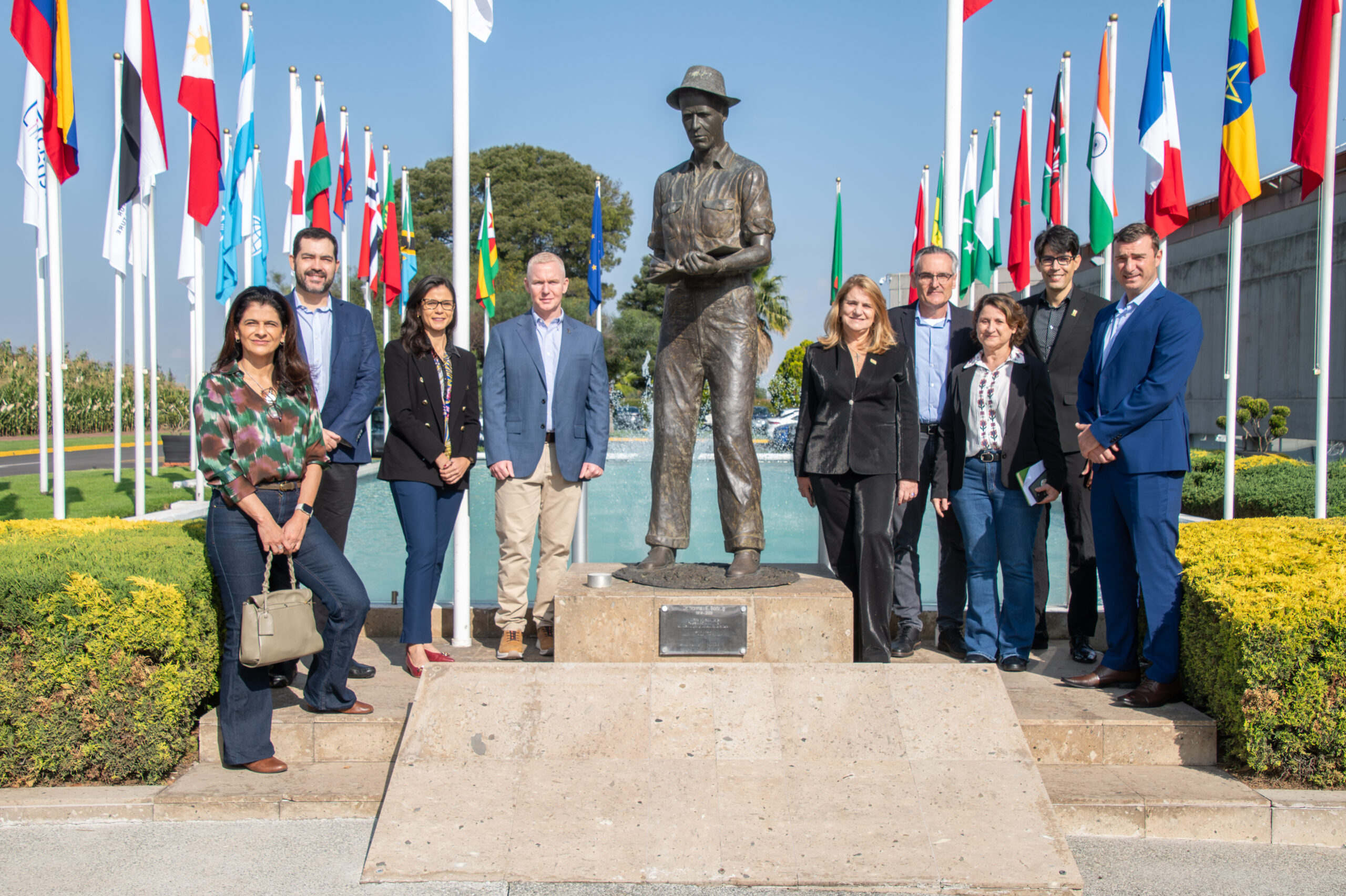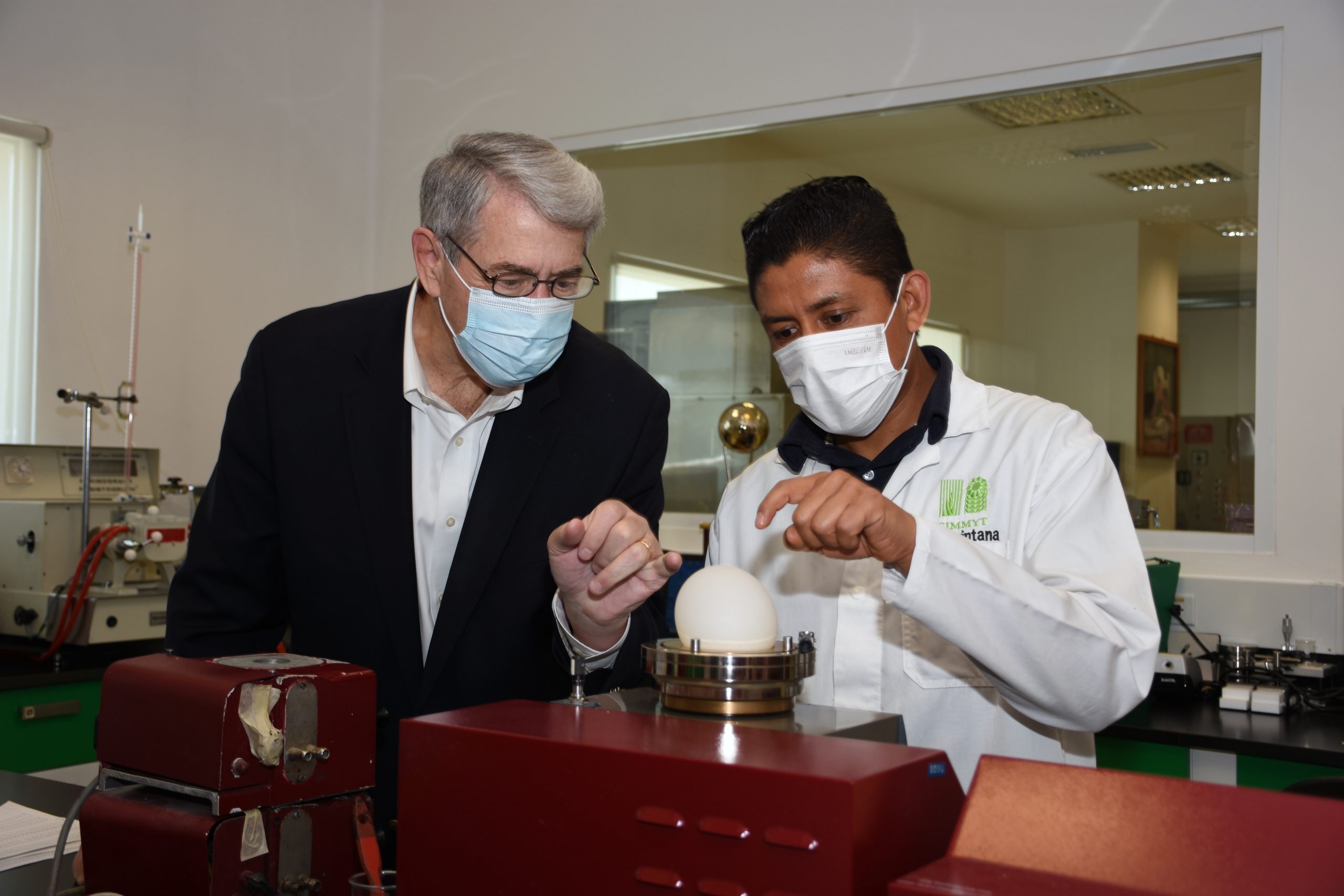
(Photo: Jenifer Morales/CIMMYT)
Texcoco, State of Mexico, September 9, 2025. The high-profile visit brought together two of the world’s most respected agricultural research institutions, with Brazil’s Embrapa – Latin America’s largest agricultural research organization – joining forces with CIMMYT’s globally recognized expertise in wheat, maize, and dryland agrifood systems. The institutions are finalizing a comprehensive Memorandum of Understanding that will formalize this groundbreaking partnership, with implications for agricultural research across Latin America and the Global South.
The program began with a welcome session and presentation by AJ Poncin, Chief Transformation Officer, and Diego Pequeno, Wheat Crop Modeler and Liaison with Brazil, who highlighted CIMMYT’s global impact, contributions to food security, and research priorities. The discussions underscored areas of common interest such as: AgTech & Digital Innovation, Low-Carbon and Regenerative Agriculture, Bioinputs and Sustainable Farming Practices, Family Farming and Mechanization, Climate Change Adaptation, Germplasm Exchange, and Sustainable and Healthy Diets. Both institutions discussed opportunities for joint research projects, scientific exchanges, workshops, seminars, technology transfer, and capacity-building initiatives.
The dialogue also emphasized the success of Brazilian agriculture, built on the combination of science and technology, capacity building, effective public policies, and innovation. Today, Brazil produces between 9 and 11 million tons of wheat per year, while consumption reaches up to 13 million tons, highlighting the need for increased productivity and resilience. Ninety-two percent of wheat production is concentrated in the south, while tropical systems already contribute 8% of national production and nearly half of total consumption. Additionally, 77% of agricultural establishments are family farms, with high adoption of sustainable practices: biological control (55%), no-till farming (83%), and integrated production systems (29%).
The distinguished Brazilian delegation received a behind-the-scenes tour of CIMMYT’s cutting-edge facilities, including: The renowned CIMMYT Museum – showcasing decades of agricultural breakthroughs, Advanced Wheat Disease Screening laboratories – protecting global crops from devastating diseases, State-of-the-art FHB Phenotyping Platform – pioneering technology in crop protection, International Wheat Nurseries – safeguarding genetic diversity for future generations, and Sustainable Agrifood System demonstrations – innovative farmer-focused research methodologies.

Delegation from Embrapa and CIMMYT representatives inside the germplasm bank, which safeguards one of the world’s most important collections of maize and wheat seeds for future food security. (Photo: Jenifer Morales/CIMMYT)
This shared context offers significant potential for collaboration in wheat improvement, sustainable intensification, and resilient agri-food systems. In this regard, CIMMYT highlighted its climate action initiatives, which include developing frameworks to measure emissions in agri-food systems, identifying practices to reduce greenhouse gas emissions, and implementing climate-smart agricultural solutions. Together with Brazil’s progress, these areas create valuable opportunities for cooperation that can support regional priorities and contribute to global sustainability discussions, including those to be addressed at COP30 in Belém, Brazil.
In her remarks, Silvia Massruhá, President of Embrapa, highlighted that Brazil’s experience shows how science and public policy have transformed tropical agriculture, and that this knowledge should now be shared through international cooperation. Likewise, Flavio Breseghello, Global Wheat Program Director at CIMMYT, pointed out that this dialogue opens a new chapter to identify collaborations and develop joint initiatives that address the region’s shared challenges. Breseghello highlighted the need to move germplasm to Brazil and implement a phenotyping platform in the Cerrado region, enabling both institutions to conduct comprehensive wheat blast resistance screening under natural tropical conditions. Also, Massruhá presented the ZARC (Agro-Climatic Risk Zoning) experience in Brazil and its potential to adapt to other regions in the Global South by CIMMYT crop modelling scientists and partners as a promising line of collaboration.
The meeting brought together representatives from various areas of both institutions. From Embrapa, participants included Silvia Massruhá, President; Sibelle de Andrade Silva, Advisor to the Presidency; and Giovani Stefani Fae, Director of Technology Transfer at Embrapa Wheat. The Embassy of Brazil in Mexico, represented by Adriane Cruvinel and Leonardo Wester, underscored the strategic character of this engagement, also conceived as a diplomatic bridge to strengthen bilateral relations in the agricultural sector.
With this shared vision, the combined scientific experience of CIMMYT and Embrapa opens new horizons for global impact. Priorities identified include developing projects to combat wheat blast in the region, expanding training programs and knowledge exchange in wheat improvement and sustainable practices, and leveraging CIMMYT’s expertise in responsible sourcing models and territorial innovation to benefit farming communities. This dialogue aims to strengthen more inclusive and resilient value chains in Latin America while contributing to global goals of food security and sustainability.

 Nutrition, health and food security
Nutrition, health and food security 